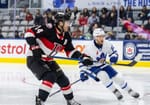Last time I looked at the revenue for the AHL in terms of growing ticket sales. This time I examine growth on the expense side.
We do not know what teams spend. We can only get general ideas buttressed with the concrete details of the salaries of players on NHL contracts. But AHL watchers, journalists and fans have been noticing trends that speak to increased money going out.
Place Bell in Laval will be the home to the Canadiens' @TheAHL affiliate as of 2017. https://t.co/fD1kO5KHYu pic.twitter.com/zdGJoLPv7C
— Canadiens Montréal (@CanadiensMTL) 11 July 2016
Called the worst kept secret in the AHL, as construction continued on the new arena in Laval, this has now been confirmed to be the future home of the Montréal affiliate for the 2017-2018 year. The Binghamton Senators are said to be moving to Belleville, Ontario, and the new Las Vegas franchise will immediately acquire their own AHL team.
Several AHL teams this year spent in other less obvious ways. Coaching staffs are growing. The Rockford IceHogs list 12 names in hockey operations, and the Marlies have a similar number with two assistant or associate coaches under Sheldon Keefe as well as a goalie coach. The coaching staff, in-house player development staff and other team support personnel are starting to make AHL teams look like, and cost like, NHL clubs. Even when the teams are owned outright by their parent club, they are building their own large support staffs.
When the Marlies flew to Bridgeport to begin the playoffs, an entire busload of extra staff drove off to meet them there because they couldn't fit on the plane.
One area where teams are moving more slowly is adding goaltending coaches. Garret Sparks has talked about the frustrations of playing in the ECHL too far away from his goalie coach in Toronto, but for most AHL teams, the only goaltending coach works for the parent club. Only 10 teams list a goaltending coach or consultant on staff as of this summer.
Some impressive salaries being paid out for #AHL free-agents. Lots in the $300-350K range. More than a few players as well.
— PATRICK WILLIAMS (@pwilliamsNHL) 2 July 2016
While there are teams being left behind on this growth and development—it is not hard to find teams with four or five people in total listed under hockey operations—even budget conscious teams are opening the wallet. On free agent day, when NHL watchers were agog over deals for Milan Lucic and Andrew Ladd, the AHL side of the fanbase were amazed to see the Colorado Avalanche drop a big chunk of cash on a handful of high-end AHL veterans, many of whom will earn around $300,000 on the AHL portion of their two-way deals.
To compete with the European leagues for talent, you either have to find players who still hope for NHL time, or you have to pay for it. The Avalanche lost four of their top five scorers to European teams before RFA season even began, so they paid for a core of AHL only players to provide stability for their prospects.
This seeming increase in pay for players coincides with a big increase in NHL RFAs who did not receive qualifying offers and were made into unrestricted free agents. Most of those players are full-time AHL roster fillers. The salary cap pressure in the NHL means many teams cannot afford to have the cap hit go up indefinitely on a player even if they plan on playing that person in the AHL. Callups to the NHL need to be at or near the minimum for a lot of teams, so having a borderline player costing you over a million in cap space when you need a depth player to fill in for the inevitable injuries is not going to work.
At the same time, much like the NHL, the middle level of AHL players are getting left out in the cold or are forced to take a pay cut. The artificially low level of pay for players on ELCs extends to the AHL too and has the same effect of team decisions.
For the players, however, their choices are not always about money.
When the Leafs chose not to make a qualifying offer to Stuart Percy that would have pushed his cap hit close to the million mark, they turned him into an UFA, and that left him and former defence partner T.J. Brennan, also a UFA, as former Marlies looking for new teams.
Percy signed with the Pittsburgh Penguins for a contract friendly to that cap-strapped team. His new deal is an increase in AHL salary, but if he gets called up to the NHL, his cap hit is only $575,000.
When it seemed almost certain the news would be Europe for Brennan, the Philadelphia Flyers announced they had signed him to a two-way deal.
If Brennan plays in the AHL, his new contract pays less than half of what he made on his one-way Leaf deal and is a small fraction of what he could have commanded in Switzerland or the KHL. If he plays in the NHL, it is still a drop in salary.
Brennan has six guys ahead of him under contract to the Flyers, and while one of those is the infamous Andrew MacDonald, there is also Ivan Provorov and Travis Sanheim waiting impatiently in the wings for their NHL careers to start.
He was signed at a time when the Flyers showed they were serious about using the Phantoms as a development environment by scooping up Andy Miele, who is one of the best forwards in the AHL. Brennan does not seem destined for the NHL.
He took that pay cut to go home, but it's about more than just home. He told it this way:
"In my mind, the Flyers were my only option," Brennan said. "To be honest, I was prepared to not play hockey this year if we couldn’t negotiate a contract with the Flyers. I’m excited that things obviously have worked out. I believe in doing things for the right reasons. I’m very ecstatic that things have worked out for numerous reasons."His hometown of Moorestown, New Jersey is the closest home town of any Flyers player they have ever signed.
"To me there’s other things besides money that go into a deal," he said. "The Philadelphia Flyers, in my mind, are going to be getting 100 percent of Terrance James Brennan. That’s really all I think they can ask for and really all that I can offer. If I signed another contract with another team for more money, I might not have been as mentally engaged because it might not have lined up with my priorities and what I wanted and what I thought was right in my life."T.J. Brennan, if it isn't obvious, is not your average hockey bro. His old friend Stuart Percy isn't either.
They did the Marlies PR stunt Twenty Questions together, and the results were interesting. They like to laugh, but they are both serious people who were willing to put on camera their arch comments about how they used to play together.
So while teams spend money to make their development environment fit for growing future NHLers, and they strive to put competitive and ever younger teams on the ice, they still have to remember that players have to want to play for them, and winning or big money is not always the only thing a player has on his mind.
But, if you want to see which teams will stagnate in the AHL this year, look at how deep the talent is behind the bench first; then look at how many of their players not on ELCs are still earning low salaries. Those teams will be left behind.
Next time: rule changes and the individual players who are getting left behind by the changing AHL.




Comment Navigation & Markdown
Navigation
cc to focus on comments section
c next comment
x previous comment
z next unread comment
Inline Styles
Bold: **Text**
Italics: *Text*
Both: ***Text***
Strikethrough: ~~Text~~
Code: `Text` used as sarcasm font at PPP
Spoiler: !!Text!!